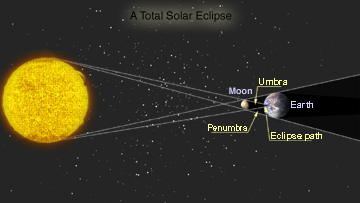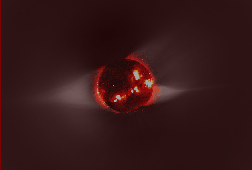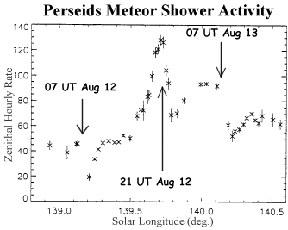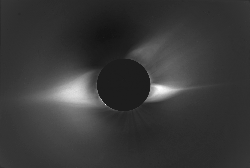The total solar eclipse of November 3, 1994. The dark ball at the center is the Moon as it passes between the Earth and the Sun.
Click on image for full size
the High Altitude Observatory, National Center for Atmospheric Research (NCAR), Boulder, Colorado, USA. NCAR is sponsored by the National Science Foundation.
Last Solar Eclipse of the Millennium on August 11
News story originally written on August 3, 1999
The last solar eclipse of this millennium was on August 11, 1999. Only people in Europe, the Middle East and India could see it. This was a total solar eclipse, which means that the Moon completely blocked out the Sun. You could see the corona during this!
When the Moon passed in front of the Sun, it covered it up! It became dark, even though it was the middle of the day. People saw the eclipse for about 2 minutes before the shadow moved. Scientists used this time to study Earth's gravity.
If you saw the eclipse, you should have protected your eyes. You should never look at the Sun directly.
You might also be interested in:

An eclipse of the Sun occurs when the Earth passes through the moon's shadow. A total eclipse of the Sun takes place when the Moon is directly between the Sun and the Earth. When a total eclipse does
...more
Rising above the Sun's chromosphere , the temperature jumps sharply from a few tens of thousands of kelvins to as much as a few million kelvins in the Sun's outer atmosphere, the solar corona. Understanding
...more
It was another exciting and frustrating year for the space science program. It seemed that every step forward led to one backwards. Either way, NASA led the way to a great century of discovery. Unfortunately,
...more
This week's solar eclipse isn't the only thing to watch! The Perseid meteor shower will peak on August 12-13, 1999. There could be as many as 150 "shooting stars" per hour. The best time to look is very
...more
The Space Shuttle Discovery lifted off from Kennedy Space Center on October 29th at 2:19 p.m. EST. The sky was clear and the weather was great. This was the America's 123rd manned space mission. A huge
...more
Scientists found a satellite orbiting the asteroid, Eugenia. This is the second one ever! A special telescope allows scientists to look through Earth's atmosphere. The first satellite found was Dactyl.
...more
The United States wants Russia to put the service module in orbit! The module is part of the International Space Station. It was supposed to be in space over 2 years ago. Russia just sent supplies to the
...more















